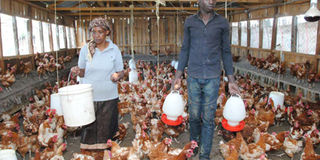Diary of a poultry farmer: One year later, path to profit from poultry is still long and winded

Employees feed layer chicken at Talents Children Mission in Elburgon, Nakuru County. Poultry farming is an undertaking that may be prone to challenges, which one has to contend with to be successful. PHOTO | JOHN NJOROGE | NATION MEDIA GROUP
What you need to know:
- My poultry adventure began as a hobby about six years ago. I started with 30 hens and three roosters, which I bought from a neighbour.
- I didn’t have my breakthrough until in October 2014 when I got my first order of 100 day-old chicks from Kalro, Naivasha.
- Things started going haywire when a disease the vets diagnosed as infectious coryza (or acute respiratory disease) struck my flock.
- If my past experience counts, after toiling to raise my chicken, come December when they are mature, I walk straight into the arms of middlemen who buy cheap to make a quick kill.
Around this time last year, I shared a mid-term report of my run in poultry. I called it the “State of the Union Address to the Poultry Nation”. I intend to do the same in this piece, but first some background.
My poultry adventure began as a hobby about six years ago. I started with 30 hens and three roosters, which I bought from a neighbour.
The problem was that for two years running, I couldn’t rear the chicks beyond two months and they kept dying despite vaccinating them.
In fact, mortality at two months was as high as 80 per cent and one farmer even told me that the birds had been bewitched.
I didn’t have my breakthrough until in October 2014 when I got my first order of 100 day-old chicks from Kalro, Naivasha.
For two years or so, things seemed to be going well. I was able to control diseases and even started formulating my own feeds and this lowered the cost by about 30 and 40 per cent.
I also bought an incubator and started hatching chicks for rearing and selling.
Further, I registered a company called Kienyeji Kenya Ltd with a matching slogan, “Fresh and flavoured by nature”.
I even received a Kenya Bureau of Standards mark meaning I could now supply my products to supermarkets.
Things started going haywire when a disease the vets diagnosed as infectious coryza (or acute respiratory disease) struck my flock (Seeds of Gold, Aug 27, 2016).
DIDN'T MINCE THEIR WORDS
At the peak of this infection in December last year, I had lost 594 (a 72 per cent death rate) of the flock.
My dream of becoming a major supplier to supermarkets came a cropper.
The good vets who kept visiting my farm didn’t mince their words. “Get rid of all your remaining stock, clean up the premises and leave it vacant for at least three months before you bring in any new stock,” one told me.
I did exactly what they told me and the results seem to be paying off. I first cleaned up the infected chicken pen (Seeds of Gold, May 20) and then I disinfected it (Seeds of Gold May 27).
Sometime in June, I brought in a new stock of day-old chicks and so far, I have only lost 41 chicks (7.4 per cent mortality at nine weeks) mainly as a result of the cold weather (Seeds of Gold, Jul 1).
I have kept the diseases at bay by combining farm hygiene practices (biosecurity) and vaccinating the birds on time.
Now to the crux of the piece. One year later, the cost of livestock feeds and the raw materials remain high despite policy initiatives by the government.
If you recall, I urged caution when five months ago, the Treasury Cabinet Secretary Henry Rotich gave a nod to millers to import yellow maize duty free for use in making animal feeds to ease pressure on white maize (Seeds of Gold April 1).
The 50kg bag of chick mash, growers and layers mash is retailing at Sh2,150, Sh2,160 and Sh2,290 respectively, which is still too high for most farmers.
GROW THE INDUSTRY
Although millers started using yellow maize to make feeds, when I checked with John my retailer in Thika, he told me that the price of a kilo of yellow maize is higher than that of white maize.
This doesn’t make sense considering that the idea was to import yellow maize cheaply for exclusive use in making animal feeds to reduce competition with white maize, which is a staple food.
According to Food and Agriculture Organisation, the poultry industry in the country is worth $6.3 billion.
But to grow the industry and protect it from cheap imports of eggs and chicken meat, the cost of feeds has to come down.
The cost of some vaccines is also too high. I just got a supplier for infectious coryza vaccine and 1,000 doses retail at Sh4,300, which cannot be compared to say, Newcastle vaccine which costs Sh570 for 500 doses.
The cost of 500 doses of fowl typhoid is Sh2,000.
Marketing outlets for eggs and chicken meat are also not well defined amid rise in imports from neighbouring countries.
If my past experience counts, after toiling to raise my chicken, come December when they are mature, I walk straight into the arms of middlemen who buy cheap to make a quick kill.
Despite these shortcomings, I remain optimistic that my venture into poultry farming will eventually pay dividends.





